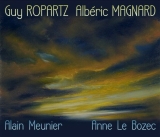Der französische Cellist Alain Meunier wurde im Juni 80 Jahre alt. Zusammen mit der etwas mehr als halb so alten Pianistin Anne Le Bozec hat er zwei Cellosonaten von Guy Ropartz und Albéric Magnard eingespielt.
Die 2. Cellosonate von Guy Ropartz entstand 1919, und mit ihrer Musik, die zwischen ‘lent, langsam’, und ‘assez animé, etwas lebhaft’ alterniert, ist sie in einer sehr ausdrucksvollen Interpretation zu hören, die nicht nur im ersten Satz das ‘ardent, leidenschaftlich’ betont. Mit ihrer klanglichen Üppigkeit und dem großen Atem wird die Komposition von Ropartz in einer aufrüttelnden Atmosphäre dargeboten. Meuniers Spiel ist sowohl im Virtuosen als auch im Kantablen immer noch beachtlich, wenn auch die Intonation nicht ganz unproblematisch ist. Anne Le Bozec gestaltet ihren Klavierpart auf einem Pleyel von 1917.
Die Cellosonate von Albéric Magnard entstand etwas früher, 1910. Magnard, der 1914 von deutschen Soldaten getötet wurde, hat damit ein teils virtuoses, teils sehr nachdenkliches Werk komponiert. Alain Meunier hatte es 2012 schon für die Reihe Les Musiciens et la Grande Guerre von Hortus aufgenommen, damals mit Philippe Guilhon-Herbert. Der Vergleich zeigt, dass die erste Aufnahme durch ihre bessere Ausgewogenheit und einen wärmeren Klang deutlich zu bevorzugen ist. Die akustische Schärfe ist im Übrigen auch der Aufnahme der Ropartz-Sonate anzulasten.
French cellist Alain Meunier turned 80 in June. Together with pianist Anne Le Bozec, who is just over half his age, he has recorded two cello sonatas by Guy Ropartz and Albéric Magnard.
The 2nd cello sonata by Guy Ropartz was written in 1919, and with its music alternating between ‘lent, slow’, and ‘assez animé, somewhat lively’, is heard in a very expressive interpretation that emphasizes the ‘ardent, passionate’ not only in the first movement. With its tonal lushness and great breath, Ropartz’s composition is presented in a stirring atmosphere. Meunier’s playing is still remarkable in both the virtuoso and the cantabile, even though the intonation is not without problems. Anne Le Bozec performs the piano part on a 1917 Pleyel.
The cello sonata by Albéric Magnard was written somewhat earlier, in 1910. Magnard, who was killed by German soldiers in 1914, composed with it a partly virtuoso, partly very thoughtful work. Alain Meunier had already recorded it in 2012 for Hortus in the Les Musiciens et la Grande Guerre series, then with Philippe Guilhon-Herbert. Comparison shows that the first recording is clearly preferable for its better balance and warmer sound. Incidentally, the acoustic sharpness is also to be blamed on the recording of the Ropartz sonata.
























